

 |
||
 |
||
Vol. 13 (1): June 2010 |
||
Croatia / Greece / Mauritania & Western Sahara / Turkey
Turkey
|
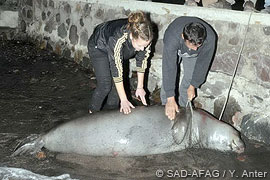 |
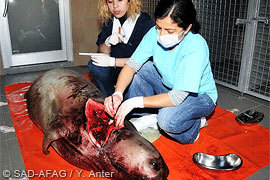 |
|
|
|
|
The female Mediterranean monk seal was shot intentionally while in the sea – most probably from a boat; she was a sub-adult around 200cm in length, weighing 150 kg. The necropsy concluded that she had been in healthy condition when shot dead.
In the second case, May 2010, the Coast Guard informed SAD-AFAG that it had discovered a dead juvenile monk seal floating on the sea surface while patrolling the northern coasts of the Dilek Peninsula near Bayrak Island. The resulting necropsy by Dr. Fulya Massozi at Yalıkavak found two hooks in the stomach but no bullets in the body. It was concluded that the cause of the death was probably due to complications from stomach wounds caused by the hooks. Based on the seal’s overall length, it was judged to have been born in 2009.
According to national legislation, Mediterranean monk seals are among Turkey’s strictly protected species; shooting a seal can incur a 10.000 TL fine (around €5000). However, SAD-AFAG, which has been carrying out studies on Mediterranean monk seals and their habitats on an ongoing basis since 1987, has yet to witness a single case of Mediterranean monk seal murderers being caught or punished for their actions in Turkey.
Although Mediterranean monk seals are protected under the Bern and Barcelona Conventions, with Turkey also a party to its protocols, no effective action has been taken to prevent such intentional killings taking place. The most promising means of reducing such killings – rather than searching out the perpetrators – is to develop sustainable fishery policies based on scientific studies, and to ensure enforcement of regulations against illegal trawlers, purse-seiners, speargun fishing, dynamite fishing and basket trap fishing. Deliberate killing of seals will only decrease when rivalry among coastal fishermen and monk seals diminishes as a result of an increase in fish stocks through better management practices. – Cem O. Kıraç, SAD-AFAG.
How many seals survive in the Mediterranean? How many were there a decade ago? Are their numbers increasing or decreasing? Are the various conservation measures applied to protect the species helpful? What is the demographic structure? What is their average home range? Are they sufficiently mobile that we can explain unusual sightings, such as in Israel or the north Adriatic?
These are just a few of the unknowns surrounding the Mediterranean monk seal that hinder the formulation of sound conservation strategies. On the other hand, these critical unknowns remain difficult to solve because the methodologies that can be applied to such a rare and widely dispersed marine mammal are very limited.
During its various research activities carried out in the northeast Mediterranean, METU-IMS has developed a methodology that may help in answering some of these unknowns. This methodology involves photo-trap deployment in caves and photo-identification of seals photographed by the traps. The numbers of identified seals captured by the periodically deployed photo-traps is used to estimate the size of the population using the Mark-Recapture technique.
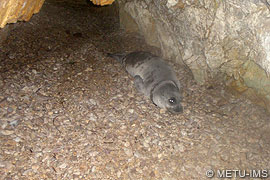 |
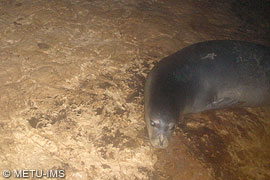 |
|
|
A newborn seal photographed by the photo-traps. |
First findings of the study: this female has been identified at two different caves 120 kilometers apart. |
So far, the method has been tested on the west coast of Mersin [TMG 10(2):2007], Iskenderun [TMG 7(2):2004], Northern Cyprus [TMG 9(2):2006], and Antalya [TMG 11(2):2008], and the results have proven successful. These experimental attempts targeted small colonies inhabiting relatively small, geographically isolated regions. As such, the resulting assessments were far from reflecting the overall population size of the northeastern Mediterranean.
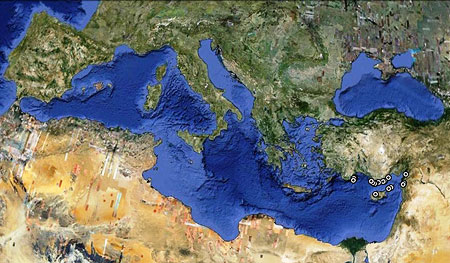
Position of the caves included in the study.
Recently, however, RAC/SPA has agreed to fund (for the Turkish coast section) a new study which covers all the small colonies discovered so far in the northeastern Mediterranean.
Deployment of the photo-trap cameras has been completed and 25 traps were placed in the caves indicated in the map above. The data collected will be retrieved in June and the photo-traps will then be re-deployed for the second phase of the assessment. The study is planned to last one complete year. – Ali Cemal Gücü, METU-IMS.
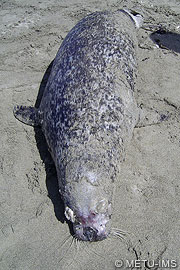 |
|
|
Harbour seal, stranded in Goksu Delta. |
On 4 April 2010, a dead seal washed ashore in Goksu Delta at the northeastern end of the Mediterranean (36° 18.0 N - 34° 01.8 E). It was first found by a Dutch bird watcher, Vim Genzevles, who immediately contacted the local authorities based in Goksu Specially Protected Area.
The examination of the carcass by IMS-METU (Institute of Marine Sciences – Middle East Technical University) scientists revealed that the seal was a female Harbour seal (Phoca vitulina).
The stranding location is far beyond the distribution range of the species. In order to learn whether the seal might have been a show animal kept in captivity in one of the dolphinariums nearby, the responsible official for CITES at the Turkish Ministry of Agriculture and Rural Affairs was contacted. However, no record of a harbour seal was found among the marine mammals brought into the country within the last 5 years. No contact could be made with neighbouring countries except Israel. Dr. Aviad Scheinin of IMMRAC (Israeli Marine Mammal Research & Assistance Center) kindly replied that Israel does not have any dolphinariums apart from the Dolphin Reef in Eilat (Red Sea) which does not keep seals. – Ali Cemal Gücü, METU-IMS.
Released in January from her temporary confinement in a specially-constructed pen in Gökova Bay, orphaned seal Badem wasted little time swimming off to Greece [New cage built for Badem, TMG news blog]. SAD-AFAG staff caring for Turkey’s most talked about pinniped had hoped that this, the latest in a string of captures and releases, would help the seal readapt to the wild, lose her interest in interacting with humans, and perhaps even find a mate. However, it was not to be.
Her first known port of call was the adjacent eastern Aegean island of Rhodes, and the popular port of Lindos.
Greek NGO MOm was alerted to the seal’s presence on 21 January 2010 by the Hydrobiological Station of Rhodes. Observers reported the animal displaying a range of un-seal-like behaviours, including resting on small fishing boats in the harbour, and allowing people to pet it. The unusual behaviour proved, in fact, the giveaway clue that allowed identification of the seal as ‘Badem’.
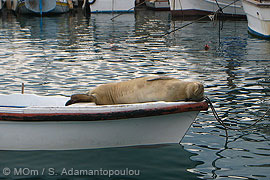 |
|
|
Badem in the popular port of Lindos, on Rhodes. |
Following contact and information exchange with their Turkish counterparts SAD-AFAG, MOm dispatched its own rescue network personnel to Rhodes in order to assess the situation, liaise with local bodies, and formulate a range of possible actions to deal with the ‘problem’ seal.
Badem became imprinted on her human carers during her lengthy 5-month rehabilitation, a condition exacerbated following her release in April 2007 by swimmers’ and beachgoers’ demands to swim and play with her. Several people have been bitten or scratched as a result.
On 23 January, MOm reported sightings of Badem in the old trade port of the island, where she was reported resting on board a boat until sunset.
She reappeared at noon the following day at neighbouring Simi island, closer again to the Turkish mainland.
MOm continued to monitor the animal’s movements through its rescue network (RINT), while drawing up a range of options to be considered by the authorities should the animal decide to remain in Greece during the busy summer tourist season.
By March, however, Badem had decided to return to her old haunts in Turkey, and was sighted near Marmaris sleeping onboard a dinghy.
SAD-AFAG’s representative Zafer Kızılkaya was quoted by the Turkish daily Hürriyet as saying: “she was resting in a dinghy, but it seems some people took advantage of this, and we received reports that some people were kicking her and throwing stones at her. Unfortunately the attitude of many Turkish people is that, when they see an animal like Badem, they want to play with her, but really it’s more like torture. This is quite intolerable.”
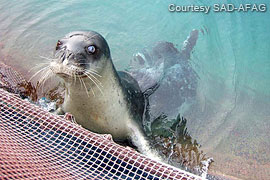 |
|
|
Badem in the newly-constructed sea pen. |
He went on: “This sort of abuse is unacceptable, but is hard to stop. A decision had already been made to take her to a secure, protected place once the season started, and this was planned for the end of May. While it is better for her to be free, it is imperative that she and her kind are safeguarded from danger and ignorant actions of people who don’t know any better.”
Badem was subsequently transferred to the newly-constructed 50m diameter sea pen in Gökova Bay, where she will spend a quiet if lonely summer away from beachgoers and swimmers. The pen, funded by wealthy Turkish businessman Mustafa Koç, was also conceived as a general rescue facility for marine animals in distress, and cost 75,000 Turkish Liras to construct (approximately €40,000).
SAD-AFAG has expressed confidence that the enclosure will allow Badem to continue to feed on live fish.
Hürriyet Daily News. 2010. New cage built for seal Badem, 3 January 2010.
Hürriyet Daily News. 2010. Mediterranean seal Badem chooses to avoid tourist season, Jane Tuna Akatay, 12 April 2010.
Hürriyet. 2010. Hürriyet Gallery: gallery of photos on Badem and her new enclosure.
SAD-AFAG. 2010. Badem back home to spend summer, 16 April 2010.
TMG. 2010. Badem escapes, then returns to summer confinement, TMG 12(2): November 2009.
TMG news blog. Badem.
Field studies on the Mediterranean monk seal and its habitats have been completed within Gökova Bay as part of the Gökova ICMM Project funded by BBI Matra.
Cem Orkun Kıraç, Nesimi Ozan Veryeri (Project Manager), Erkin Tonguc (SAD-AFAG research team) and Can Görgün (chairman of the Akyaka Fisheries Cooperative, who has wide experience of the area) participated in the surveys, which took place between 4-9 May 2010.
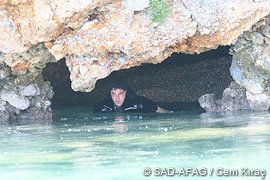 |
|
|
Cave survey along the northern coasts of Gökova Bay. May 2010. |
The studies began on the northern side of the Gökova Special Environmental Protection Area (SEPA), which has a 207km long coastline in total. The research team subsequently undertook coastal surveys and observations covering the entire Gökova SEPA region and the islands. Fieldwork was carried out using a 8.5m fishing boat navigating at low speed. Potential habitats of the Mediterranean monk seal were discovered while distinctive and impressive new information was gathered on coastal and marine habitats. Breeding habitats of the Mediterranean monk seal were identified and an adult female observed and photographed. The adult female, which was found in a cave along the northern coasts of Gökova Bay between Akyaka and Ören, was also filmed using a digital camera. The entire coastline was also photographed by digital camera and the caves / caverns mapped. Suitable caves were checked for the presence of seal(s) or traces. Survey results reveal that the northern coasts of Gökova SEPA have a significant number of caves and caverns, two of which bore monk seal traces.
Face to face interviews with the local artisanal fishermen, in order to gather firsthand monk seal observations and information on factors threatening the species and its habitats, will continue during the summer of 2010. The data derived from the survey will assist in developing the draft management plan to be prepared for the Gökova SEPA Region in association with SAD-AFAG, local NGOs, EPASA (Environment Protection Agency for Special Areas), MARA (Ministry of Agriculture and Rural Affairs) and other stakeholders, including artisanal fishermen. – Cem O. Kıraç, N. Ozan Veryeri and H. Güçlüsoy, SAD-AFAG.
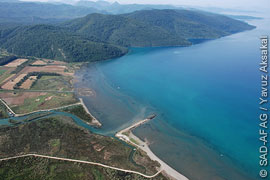 |
|
|
|
Habitat destruction was observed along the coastline of the Gökova SEPA during May 2010. Local people and NGOs, including Gökova Akyakayı Sevenler Derneği (GAS Der), alerted SAD-AFAG to this unexpected development. Supported by photos and video evidence the initial report revealed that a 200-250m length of coastline, including coastal wetland with reed beds, had been filled with earth using heavy construction machinery and trucks, to a width of approximately 10m. Paradoxically, this destruction occurred in the middle of a coastal zone management planning project carried out by the NGOs in cooperation with EPASA and MARA. The Gökçe village elder is deemed responsible, having taking this action unilaterally, without the permission of the relevant authorities. Upon intervention by SAD-AFAG and GAS Der, the village elder agreed on 14 May to cease the construction immediately and to restore the area. Unfortunately, he had previously attempted to cover up the illegal work using wetland mud and soil, making things worse rather than better.
SAD-AFAG and GAS Der immediately reported the matter to EPASA, requesting that the organization take steps to halt the destruction and restore the area to its original condition. The protection of such unspoilt coasts have utmost importance for the conservation of endangered marine and coastal species such as the monk seal, Eurasian otters, osprey, terns, Audouiin’s gull, little egrets and other sea and shore birds. – N. Ozan Veryeri and Cem O. Kıraç, SAD-AFAG and Bahar Suseven, GAS Der.
In October 2009 SAD-AFAG was requested by the Ministry of Environment and Forestry to provide its opinion on the possible environmental impacts of a port construction project planned for Arslan Cape, Mimoza Bay, on the Karaburun Peninsula, by the DLH İzmir Transportation Regional Directorate.
The project envisages the construction of a 220m long jetty, an 80m long and 10m wide landing-stage, and a 51m long additional pier. Two 20m long slopes constructed on the edges of adjacent piers would serve as boat access for passengers and vehicles.
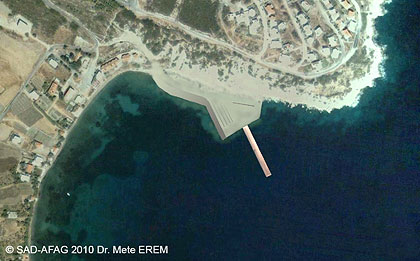
Artist’s impression of the Arslan Cape construction, based on current plans.
Under the plan, ferryboats with the capacity of 20 vehicles and 250 passengers will sail the route between İzmir - Foça - Mordoğan - Karaburun. Although dredging would not be performed, land filling would cover approximately 9.500m2. Water depth is around 0-6 meters in the area. According to the calculations, approximately 47.500m3 coastal fill would be required.
In the event that the port construction comes to realisation, some species like the Mediterranean monk seal and sea grass (Posidonia oceanica) would in our view be seriously threatened and coastal and marine habitats suffer deterioration. While Arslan Cape does not hold a breeding cave, numerous seal sightings in the vicinity have been recorded by SAD-AFAG from 1991 - 2009 [See Karaburun and the Mediterranean Monk Seal, below].
SAD-AFAG believes that an alternative investment could be realised by using the already existing Saipaltı Port area, approximately 700m south of Arslan Cape, or Karaburun Port, about 1km north, both of which offer similar opportunities for less cost and environmental impact. Recent rumours suggest that the investor is on the verge of giving up on the Arslan Cape project. However, if that does not transpire, SAD-AFAG is willing to take court action in an effort to prevent it going ahead. – N. Ozan Veryeri and Cem O. Kıraç, SAD-AFAG.
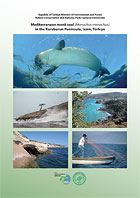
A new publication on Karaburun and the monk seal has been prepared by SAD-AFAG, and published by the Turkish Ministry of Environment and Forestry in December 2009.
This publication underlines the importance of Mediterranean monk seals as one of the rarest animals in the world, and as symbolising a need for protection of the marine and coastal ecosystems as a whole. The book presents a comprehensive assessment of the species, as well as its habitats and the threats it faces around the Karaburun Peninsula – one of the 5 high priority monk seal areas in Turkey. The publication also compares the past and current status of monk seals and habitats on the Karaburun Peninsula, and presents an analysis of the threats and further measures to be taken for its protection. – Eren Özden, SAD-AFAG.
Kıraç, C.O. and N.O. Veryeri. 2009. Mediterranean monk seal (Monachus monachus) in the Karaburun Peninsula, İzmir, Türkiye. Ministry of Environment and Forest. December 2009, Ankara: 1-40. [PDF  18.5MB]
18.5MB]
EndQuoteThe boon of peace in military zones The UN realized that biodiversity loss was a critical problem back in 1992 and has been working to halt the decline in numbers of species on the planet ever since. A major part of that effort involves preserving "biodiversity hot spots" - chunks of habitat where the broadest and most diverse array of species can be found. There are over 10 recognized biodiversity hot spots along the route of the former Iron Curtain, which has lead scientists to more closely evaluate the biodiversity of military border zones, such as the Demilitarized Zone in Korea and the Green Line in Cyprus. […] Fishermen in coastal villages bordering the Green Line have spotted Mediterranean Monk Seals, one of the most endangered mammals on the planet due to hunting and habitat loss. The seals have been hunted since the times of the Roman Empire and fishermen to this day view them as pesky competitors for fish. "Due to the shy nature of the Monk Seal these areas are ideal for them to rest and maybe even breed," says Wayne Fuller, a research scientist at the European University of Lefke in North Cyprus. Fuller added that it's unclear how many seals there are, but that this undisturbed coastline habitat could be critical to their continued existence. [...]
|

Copyright © 2010 The Monachus Guardian. All Rights Reserved |